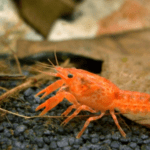Beyond marine selections like emerald crabs (Mithrax sp.) or Hawaiian red reef crabs popularized in saltwater systems, various suitable freshwater crab species also make fascinating oddities for specialized aquarists able to accommodate their unique needs within home setups properly.
Red Claw Crabs
The most popular freshwater crab variety keeps growing in recognition.
Identifying Traits
Red claw crabs (Perisesarma bidens) reach 2-3 inches bearing reddish legs coupled with a mottled brown carapace making them instantly recognizable. Peaceful dispositions and completely aquatic adaptations lend well towards aquarium life.
Housing Needs
These brachyuran crabs require paludarium style enclosures providing half aquatic and dry land areas. Heavily planted setups with overhanging basking zones allow dividing their time between both areas conveniently while limiting potential escape artists!
Fiddler Crabs
Named tellingly for one oversized claw in males, fiddler crabs offer another common pick.
Identifying Traits
Several color morphs exist but identification centers upon males featuring a single massively enlarged red or yellow tinted claw outstretching their bodies. Females instead have two smaller equal sized pincers lacking bright colors.
Housing Needs
Fiddlers need the same divided wet/dry habitat allowing alternating immersion opportunities. However burrowing tendencies demand deep sand beds. Avoid housing fiddlers with fish able to consume tiny crab lings.
Thai Micro Crabs
These tiny freshwater crab variants claim intrigue from nano setup aquarists.
Identifying Traits
Tiny round crab bodies measuring only 0.6 inch fully grown characterize Thai micro crabs (Limnopilos naiyanetri). Their appearance resembles mini marine spider crabs. Delicate peaceful dispositions limit housing combos able to accommodate them.
Housing Needs
Successful long term Thai micro crab care requires stabilized setups with gentle fish unlikely to attack or consume them. Planted shrimp breeding tanks work well. However, these microbenthic crabs require specialized care exceeding levels other freshwater species need.
Vampire Crabs
Lastly vampire crabs allure with their curiously marked legs and terrestrial behaviors.
Identifying Traits
Vampire crabs feature black and purple banding on leg joints lending them an almost spider-like appearance as semiterrestrial crabs only requiring partial moisture retaining substrate conditions avoiding standing water with gills not adapted towards permanent immersion.
Housing Needs
Vampire crabs live predominantly land based but require a perpetually highly humid palludarium type enclosure with pools for drinking and humidity. Avoid combining them with fish.
Conclusion
Freshwater crabs make uniquely engaging exotic aquatic pets but require species specific environments catering towards individual nuanced needs unlike fish properly. Confirm capacity properly furnishing sizeable setups accommodating essential mix terrestrial and aquatic areas facilitated before obtaining these fantastically different crustaceans certainly commanding proper preparations beforehand!
FAQs About Freshwater Crabs
1. Do freshwater crabs need land?
Yes. Unlike fully aquatic marine crabs, all freshwater crab species retain essential biological functions demanding retaining a dry land area allowing periods of emersed breathing using specialized lung-like organs to varying degrees dictated by individual species types assessed before acquiring specimens.
2. What’s the largest freshwater crab?
The Australian giant freshwater crab (Austrothelphusa transversa) claims the largest size reaching over 12 inches claw to claw, however virtually no other freshwater varieties surpass 6 inches, with many remaining under 3 inch maximum lengths at maturity.
3. Do freshwater crabs need salt water?
Pure freshwater suits all commonly kept aquarium crab species just fine, unlike marine crabs requiring some salt. However always use dechlorinated, conditioned tap water matching normal parameters they naturally inhabit.
4. Can fiddler crabs live fully submerged?
No. male fiddler crabs featuring overgrown claws require access towards dry land regularly. Even females that lack enlarged pincers depend upon emersed breathing through developed lung structures unable to survive fully submerged lacking sufficient gill adaptations towards permanent water breathing.
5. How long do freshwater crabs live in captivity?
Average captive lifespans range 1-3 years for most freshwater crab species given properly setup enclosures. However vampire crabs and Thai micro crabs often only surviving one year unfortunately as more sensitive choices despite intensive husbandry efforts.


